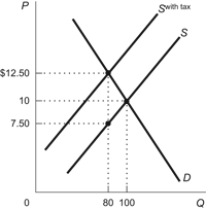Figure: Supply and Demand with Tax on Suppliers 
Using the graph shown, answer the following questions.
a. What was the equilibrium price in this market before the tax?
b. What is the amount of the tax?
c. How much of the tax will the buyers pay?
d. How much of the tax will the sellers pay?
e. How much will the buyer pay for the product after the tax is imposed?
f. How much will the seller receive after the tax is imposed?
g. As a result of the tax, what has happened to the level of market activity?
Definitions:
Bohr Effect
Named for Danish physiologist Christian Bohr (1855–1911). Shift of the oxygen-hemoglobin dissociation curve to the right or left because of changes in blood pH. The definition sometimes is extended to include shifts caused by changes in blood carbon dioxide levels.
Oxygen-Hemoglobin Dissociation Curve
A graph showing the relationship between the oxygen saturation of hemoglobin and the partial pressure of oxygen in the blood.
pH
A scale used to specify the acidity or basicity of an aqueous solution, ranging from 0 to 14, where 7 is neutral.
Bicarbonate Ion
A crucial buffer ion (HCO3-) in the blood, responsible for maintaining the body's acid-base balance, it is also involved in transporting carbon dioxide out of tissues.
Q7: (Figure: Hollywood Stock Exchange) Refer to the
Q9: If a tax is levied on the
Q20: (Figure: Gun Market) In the gun market
Q47: Imagine the existence of prediction markets for
Q51: If the price of Good X rises
Q53: Which of the following statements is TRUE?
Q142: The manager of a company notices that
Q245: John and Tom enter into a futures
Q248: Speculators who think that a war in
Q263: The elasticity of demand for oil is